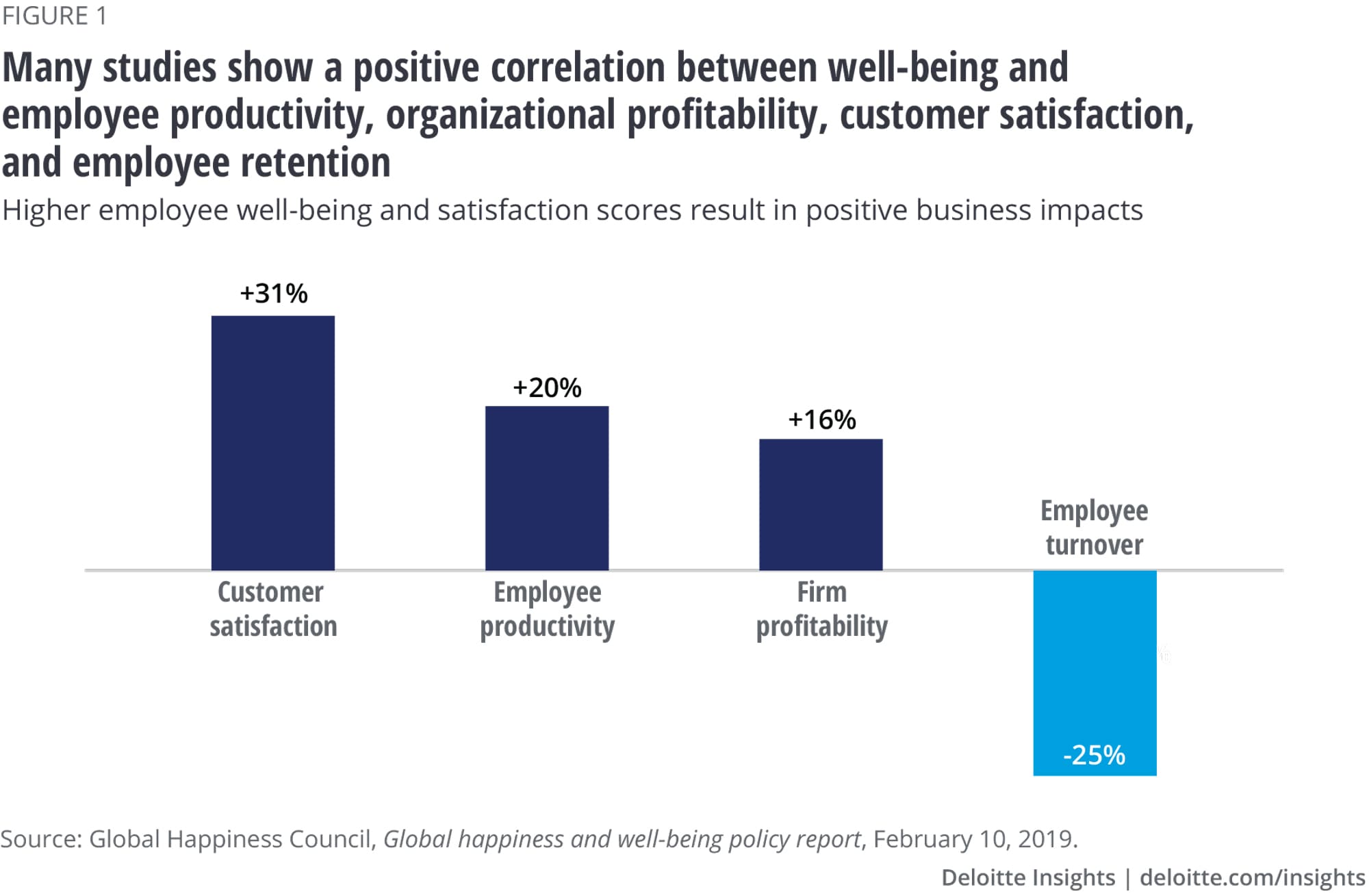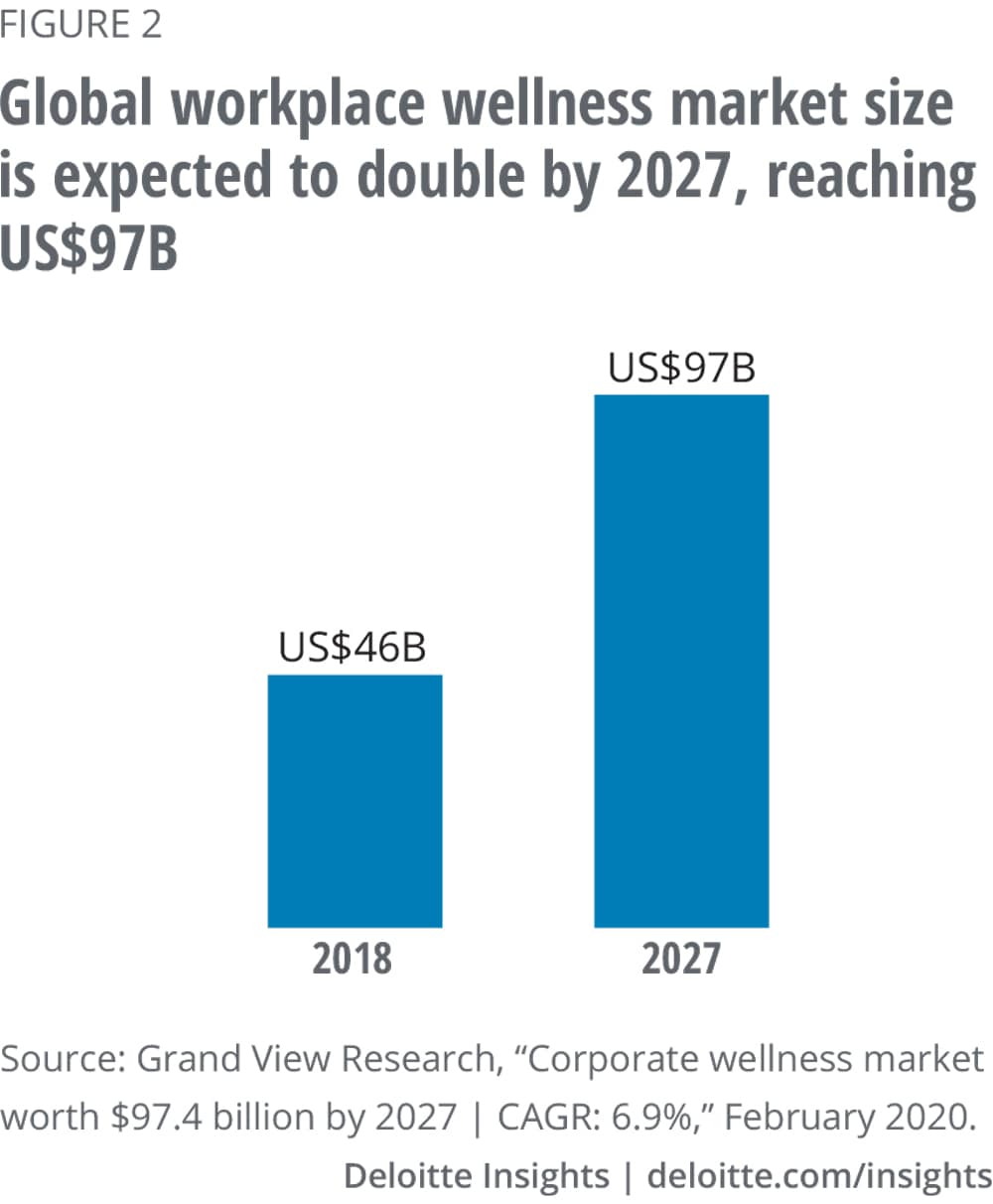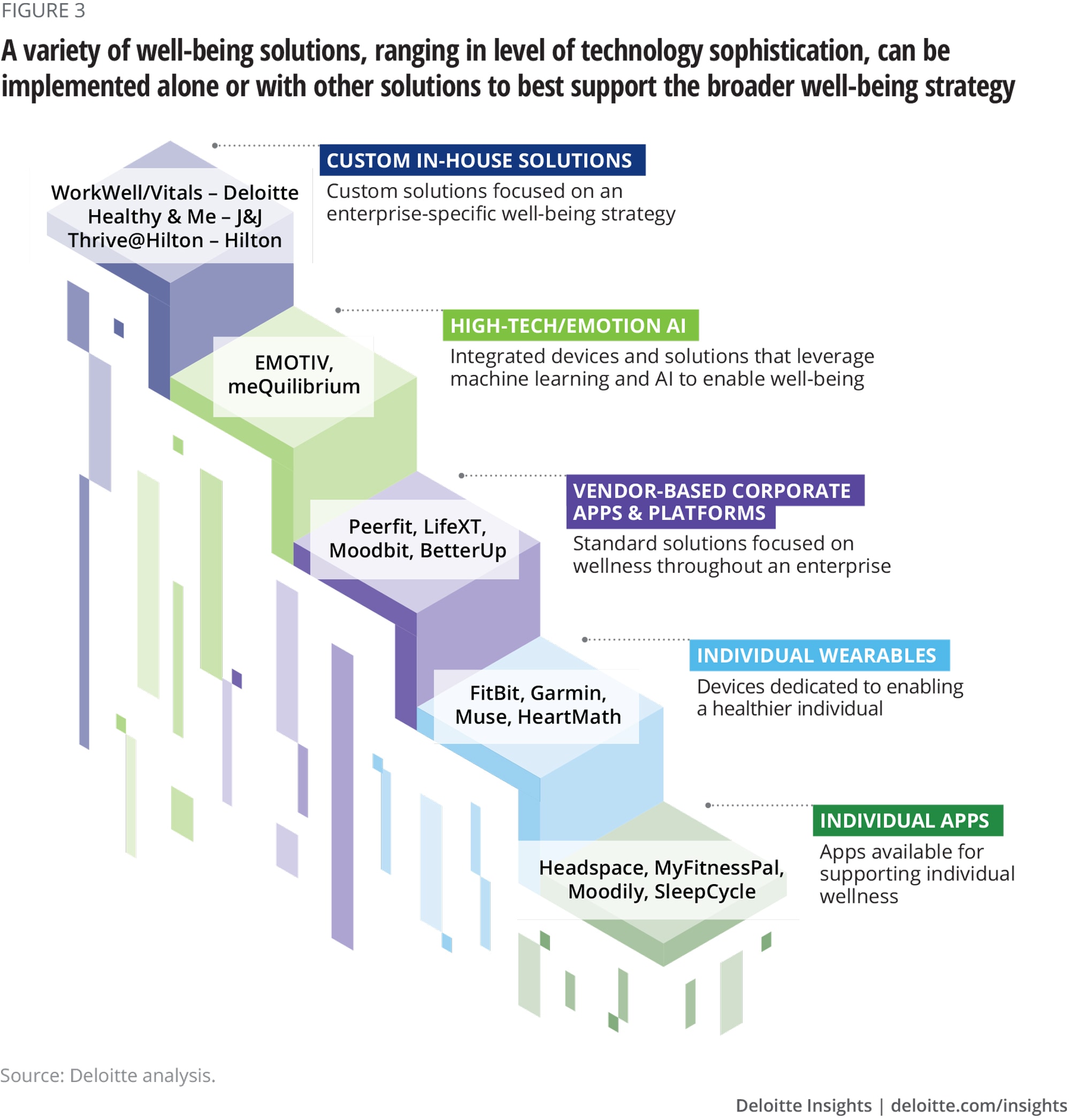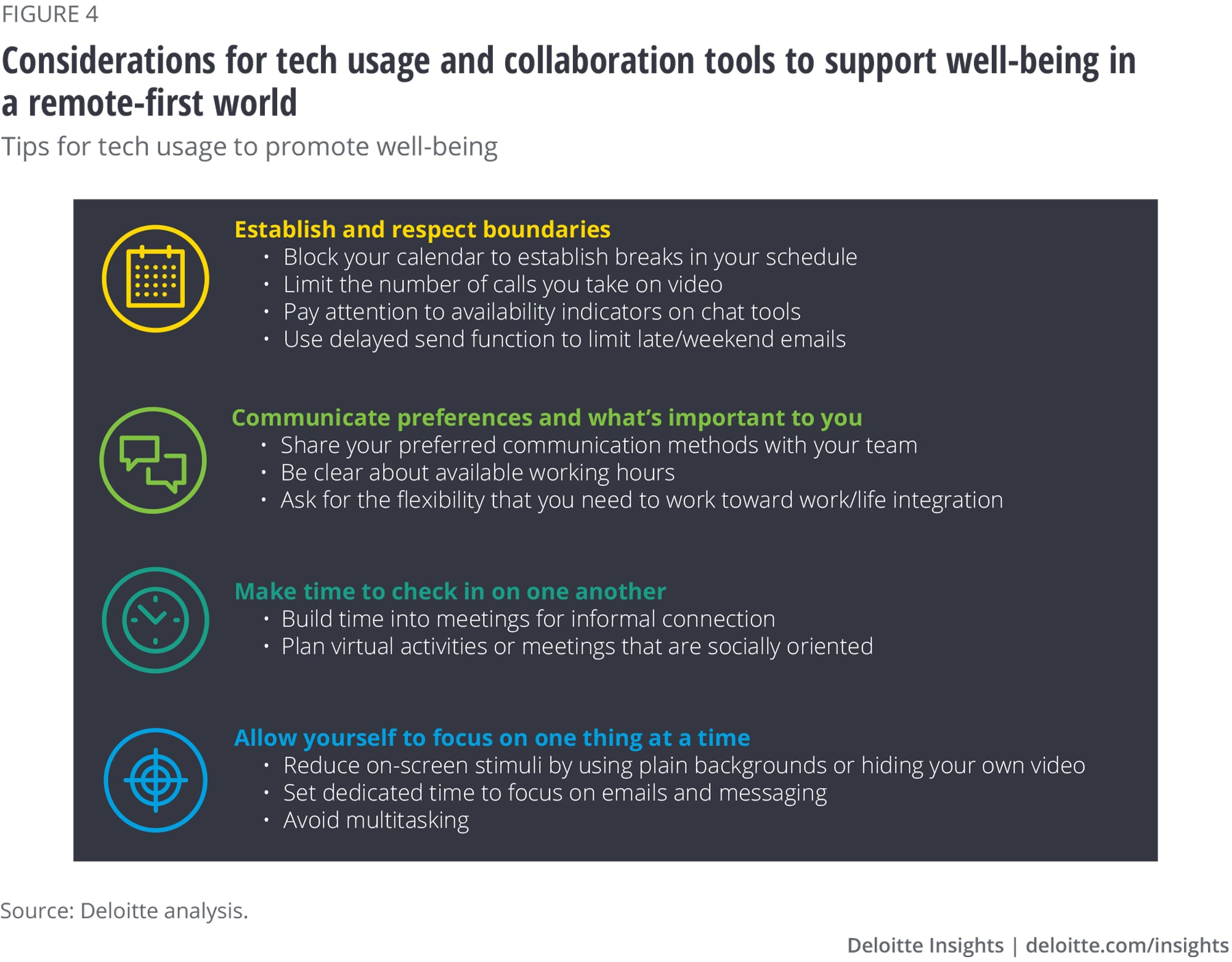
Integrating tech and well-being The vital role of technology executives
14 minute read
08 September 2020
With much of the business world shifting to a work-from-home model, sustaining employee well-being is increasingly challenging for enterprises. Integrating technology into well-being strategies may hold the key—with tech leaders playing a pivotal role in driving the adoption of such tools.
After several hours of videoconferencing with her team, a data scientist tries to focus on the code she needs to review, but her laptop sends her a message: “Katrina, it’s time for a break. Do you want to take a short walk or do a five-minute guided meditation to reset your focus?”
Learn more
Explore the Diversity and Inclusion in Tech collection
Learn about Deloitte‘s services
Go straight to smart. Get the Deloitte Insights app
The data scientist is wearing brain-sensing earbuds that contain electrodes measuring her brain’s electrical activity. The device looks and functions like standard Bluetooth earbuds, but squeezed inside is a mobile EEG lab that can measure and analyze levels of stress and distraction, providing immediate feedback to improve individual employee well-being, performance, productivity, and safety. Depending on brain activity, machine-learning algorithms may instruct workers to take breaks when they’re tired, change the difficulty or format of an interactive training when an employee is unfocused, or switch an anxious employee to a less stressful task.
This may sound like science fiction, but some leading companies are already introducing similar devices.1 It is also just one example of a wide range of technology solutions that are designed to enhance and promote well-being in the workplace. These solutions range from simple activity trackers and meditation apps to sophisticated machine learning devices that deliver customized content and recommendations to reduce stress and fatigue based on the individual’s interests or even real-time brain activity.
A growing number of companies are exploring technology solutions as elements of a holistic enterprise-wide strategy to enhance employee well-being with the goals of improving individual performance, resilience, mental and physical health, and job satisfaction. Properly designed well-being programs can complement diversity and inclusion strategies to enhance each individual worker’s feeling of belonging and understanding, leading to enhanced organization performance.
While well-being programs are often led by human resources (HR) professionals, technology leaders have a critical role to play as they guide and catalyze tech-enabled strategies to address increasingly complex well-being work challenges.
Now more than ever: Well-being’s value
Today, workers are likely dealing with external and internal stressors, which can affect their productivity, health, and family stability. Even before the 2020 pandemic and financial recession, 40% of all workers experienced high stress levels and anxiety, according to a survey conducted by the Anxiety and Depression Association of America.2
Technology was the leading driver that enabled office workers to transform into remote workers overnight. But as the line between work life and personal life continues to blur, many employees report having trouble maintaining a sense of overall well-being. The good news is that while technology is part of this problem, it can also be part of a holistic solution.
Nuno Barboza, vice president of Strategy and Deployment, J&J, North America, says, “We have a tremendous opportunity to improve well-being from a tech perspective. When the pandemic began, we were able to quickly transition most of our workers to work remotely. By enabling people to operate successfully, we can help create a more balanced individual, with lower levels of conflict and stress.”3 In fact, studies have shown that well-being is positively correlated with employee productivity, organizational profitability, customer satisfaction, and employee retention (figure 1), according to the Global happiness and well-being policy report published in 2019 by the Global Happiness Council.4

In recent years, many companies have made significant investments in worker well-being, and a new and growing startup industry focused on well-being and technology has emerged. Estimations from January 2020 indicate that the global corporate wellness market is likely to expand at a compound annual growth rate of 6.9% to reach US$97.4 billion by 2027 (figure 2).5

Eighty percent of respondents to Deloitte’s 2020 Global Human Capital Trends survey identified well-being as an important or very important priority for their organization’s success over the next 12–18 months, but only 12% reported that they are “very ready” to address this issue.6 Of organizations with well-being strategies, about one-third focus on physical, mental, and financial health of employees, with an additional 20% expanding that definition to include providing a workforce experience that provides purpose and meaning.
Unfortunately, 61% of organizations participating in the trends survey are not measuring the impact of well-being on organizational performance, and those that do were most likely to report that the primary benefit was improving the workforce experience. Fewer than half believed that their well-being strategy was positively affecting other business outcomes, such as the organization’s customer experience, financial outcomes, reputation, and innovation and adaptability.
Jen Fisher, chief well-being officer at Deloitte, says, “Organizations that expand their focus on worker well-being from programs adjacent to work to designing well-being into the work itself can help their workers not only feel their best, but also perform at their best. Doing so can strengthen the tie between well-being and organizational outcomes, driving meaningful work, and foster a greater sense of belonging overall.”
The tech leader’s role in an integrated well-being strategy
Technology and work today are inextricably intertwined, calling for technology leaders to fulfill vital roles in supporting organizational resilience and performance—including how people and machines engage to get work done. There’s a growing need for tech leaders to join forces with HR, well-being, and business leaders to ensure that the enterprise remains distinctly humanistic by designing and executing a holistic strategy that embeds well-being into cultural norms, workflows and processes, and technology decisions.
And of course, prior to implementing well-being strategies, organizations should consult with their legal and privacy teams to understand what, if any, notices to/consents from employees may be appropriate, as well as how they can use and safeguard any well-being data that is collected.
Be the catalyst for integrating well-being into work
In an ideal world, workers could opt-in to technology solutions that promote, track, manage, and measure well-being that may be seamlessly integrated into the work and collaboration tools they use every day. These tools would include artificial intelligence (AI) capabilities to help leaders understand individuals’ behaviors and how they change over time, while reinforcing and optimizing healthy behaviors. While there are a growing number of vendors offering solutions to support workplace well-being, there is no “one-size-fits-all” solution because every culture and individual is unique.
At Hilton, employees (referred to as Team Members) are on the go—serving guests, cleaning, solving problems—so solutions are designed to be mobile and easily accessible. Kellie Romack, vice president of Digital HR and Strategic Delivery at Hilton, says, “While we’re focused on wellness and tools that make lives easier, we also want to make sure Team Members are utilizing tools they already know.” Her team adapts the work tools that workers are already using, limiting the number of new technologies that Team Members must learn. They also want to make tools easy to access: “Our HR self-service, collaboration, and well-being tools are accessed through one unified login; you have one login to everything Hilton—one place, one login, one-stop-shop.”7
Romack says, “The pandemic has made everyone look at new shiny tools, many which stand alone. But the key is finding technology solutions that truly integrate and filter down from a usability and functionality perspective. We can build any technology as a stand-alone, but is that really success? How does it fold in? How is it meaningful? What solutions can we get rid of if we use this? What is the value to the Team Member?”
Vendors are listening. Increasingly, companies are designing well-being solutions to augment work tools employees use throughout the day. For example, Moodbit is an employee engagement technology that can be easily installed on many enterprise communications tools. The AI-powered solution analyzes text, content, and communication patterns or text conversations while protecting individuals’ privacy. According to Miho Shoji, Moodbit’s CEO and founder, “The goal is to measure morale in real time so that leaders take corresponding action quickly, rather than relying on annual surveys.”8
Brenda Jacobsen, CEO of LifeXT, an employee engagement program that combines digital tools with one-on-one coaching, advises leaders to select solutions based on the needs of the target audience: “There’s a spectrum of solutions on the market with varying levels of engagement. The target audience may favor a tech-heavy solution or a more coach-centric, high-touch solution, or a combination. Offering a menu of choices, especially for a large population, will help organizations meet the needs of as many employees as possible. It’s unrealistic to think that one solution can do that.”9

Design technology-enabled solutions fit for purpose
Rather than wait for a comprehensive technology solution, tech leaders are increasingly collaborating with HR and business leaders to build, adapt, or assemble their own well-being platforms to complement the organization’s existing work and collaboration tools, with cyber and privacy in mind. Regardless of whether an organization builds their own from scratch or leverages one or several vendor technology solutions, leaders should consider these best practices:
Define the strategy. For many organizations, linking their well-being strategy to their core values is a natural starting point. Listening to employees through periodic surveys can also point to pervasive well-being issues that are important to address.
Build the business case. Clearly define the organizational issues that the well-being strategy will address and the expected outcomes—and demonstrate how those outcomes will be measured. Depending on the organization’s objectives, define relevant KPIs for measuring the effectiveness of the well-being strategy over time. Avoid recreating the wheel—and build credibility—by leveraging enterprise metrics that already exist and are broadly communicated.
“Every dollar is being scrutinized these days, so a data-first or measurement-first approach is important to proving ROI”10—Jamie Jarman, general manager, BetterUp
Identify high-value solutions. Prioritize organizational performance and/or employee satisfaction issues related to well-being as a starting point in order for new or expanded well-being solutions to be effective. For example, J&J’s employee surveys show that their workers are feeling overwhelmed by the remote work environment. Juliana Nunes, global head of HR for Enterprise Technology at J&J, says, “I’m using MyAnalytics by Microsoft to help me prioritize my own workload. If we could leverage something like this for the entire organization, it could help others as well. I think helping people manage their time could be the next big wellness wave.”11
Design with purpose in mind. Avoid getting tangled up in whether to buy or build a technology solution. Select the option that will best fulfill the well-being goals and practical objectives you’re trying to satisfy and move forward.
“The biggest advice I would give people is it’s not about the technology. It's about the purpose.”12—Kellie Romack, vice president of Digital HR and Strategic Delivery, Hilton
Support diverse users. Design technology-enabled solutions with diverse end users in mind, considering any possible unintended biases. Support an inclusive work environment by giving individuals the flexibility to decide how and when they want to use the technology and the ability to tailor the experience to their unique needs.
Ensure scalability in a remote-first work environment. The 2020 pandemic demonstrated the value of being able to scale overnight to accommodate remote workers. Consider these requirements: Will the solution work across global time zones? Could all employees access the apps at once, if needed? Is the solution priced so that it’s affordable for organization-wide use?
Provide remote user support. Avoid worker frustration and stress by deploying self-service apps, support chat, and other support to address user issues across time zones and flexible work hours. Provide access to ergonomic equipment and furniture to promote healthy bodies while working remotely from home.
Measure and report impact. Leading organizations integrate well-being measurement and reporting into their overall reporting and performance systems. For example, J&J’s performance metrics for CIOs includes “cultural health,” which measures employee adoption of well-being programs that support healthy habits, alongside more traditional metrics, such as talent pipeline and retention.
Embed tech boundaries into the organization’s culture
An organization’s culture is not the mission and values statement posted on its website. While these are foundationally important, the actual culture is often unspoken, constituting millions of small, everyday decisions and behaviors that build over time to influence how its people interact and get work done.
The 2020 pandemic upended the cultural norms of many organizations as office workers were abruptly shifted to remote work. This move emphasized the importance of technology’s role in how, when, and where work is done. Even some leaders who were reluctant to support remote work have acknowledged that it can be as effective as in-person meetings and collaboration.
In March 2020, just as COVID-19 was reaching pandemic status, Aetna International conducted an international study on technology’s impact on worker health. While the survey’s timing with the pandemic was sheer coincidence, its purpose was rooted in modern working culture and context. Aetna’s research showed that 83% of workers agree that technology enables them to work remotely and balance life and work, and 81% agree that technology improves communication with colleagues. In the wake of the pandemic, many employees and organizations have witnessed first hand that a remote work environment can also lead to an “always on” cultural expectation that can adversely affect worker well-being—which is the culture Aetna’s study was created in response to. Aetna’s study found that 66% of workers agree that working from home blurs the lines between work life and home life, and 60% agree that working from home increases the pressure to respond to work outside of office hours.13
In addition to ensuring workers understand how to use technology to perform work, technology leaders can support organizational well-being by promoting best practices for when to use technology.
Nunes oversees 4,300 people globally. She partners with the CIO and his leadership team to make sure they have the right talent to drive their technology agenda, but also that they “create the right environment where people can bring their natural best.” Nunes says, “The leadership team explores work principles that support wellness. For example, we decided not to hold meetings during lunchtime—which we defined as an hour, not 30 minutes—because a lot of people need to break, be with their kids, and then come back. Rather than sending an email to the entire organization to not hold meetings during lunchtime, the leadership team chose to lead by doing, demonstrating to our people that we’re respectful of their time.”14
Darwin Deano, principal, Deloitte Consulting LLP, has seen the effect of work stress on teams managing large systems implementations. He says, “I look at well-being as your only way to not be blindsided by the negative effects of stress. Neglecting well-being for professionals may not matter at first, but, over time, it can create serious health problems.15
While stress is likely unavoidable when working on time-critical projects, there are workarounds. For instance, the implementation team for a leading global beverage company looked for small changes that could have a big impact on the team’s well-being, such as agreeing not to send emails after 5 pm. If an urgent issue came up, they would send a text instead. This practice eliminated the need for team members to continually check email after hours, knowing that if a message is critical, they would get a text.
One of the tech leader’s roles is to support the organization’s intentional use of technology to support organizational strategies, employee productivity, and customer engagement. Following the massive shift to work from home, boundaries between the professional and the personal have blurred. It’s up to leaders to be much more intentional, set boundaries, and be much more thoughtful about technology use while keeping well-being in mind: how we use it, who we talk to, when we talk to them, how we structure meetings. Being intentional and continuing that practice will enhance well-being well into the future, regardless of the work environment.

Lessons learned
The leaders we interviewed stressed that well-being needs are unique to each worker and organization, but several of their recommendations were ubiquitous:
- Technology doesn’t replace leadership. No technology solution can replace the uniquely human skill of effective leadership. Erica Volini, principal and global human capital leader, Deloitte Consulting LLC, says, “I would encourage leaders to think about how to use technologies in the context of their organization’s culture. I would consider investing in leadership training on how to manage virtual teams, rather than recreating tech functionality that already exists in the marketplace.”16
- Focus on intrinsic—not extrinsic—rewards. Many early well-being strategies were based on extrinsic rewards. For example, employees who met a steps-walked-per-day goal would earn a water bottle or other merchandise. But organizations found that employee participation dropped off quickly—leaders at a major bank, for instance, realized that focusing on extrinsic rewards with a singular focus, such as physical health, without addressing the full person, may dilute the well-being program’s success.
- Engage employees to support adoption. Romack says, “The hardest thing is adoption. You can't just build it and they’ll come. You have to create something that addresses a need and make it user friendly and accessible.” To do this, Hilton surveyed Team Members to identify well-being issues they consider most important. They held focus groups to listen to front-line workers and engaged them in design and implementation. To support adoption, they solicited the help of influential workers in each hotel, creating a “change champion network.” Romack says, “If one person can influence 100, then you only need 250 to get a lot of people on board at once.”17
Deloitte’s well-being technology journey
Opportunity
Deloitte’s US chief well-being officer, Jen Fisher, brought together leaders from IT, Talent (HR), and the business to develop a tool that would help Deloitte professionals manage their work-life integration, which employee surveys had identified as a problem. The team’s goal was to identify and track warning signs of burnout so that they could be addressed early on. The team conducted research and focus groups but could not find a vendor solution that provided the data-driven, integrated solution Fisher envisioned.
The technology solution: Vitals
In 2015, the team developed and launched Vitals, a technology solution that helps drive employee well-being through data and analytics. By compiling existing, disparate data points into an interactive dashboard, Vitals equips employees and their leaders with important well-being data, which can enable proactive, two-way conversations to mitigate burnout and promote work-life integration.
Vitals brings together data across multiple systems to capture regular and weekend hours worked, paid time off (PTO), travel details (e.g., nights in a hotel, number of flights and train rides), and weekly self-reported energy levels (low, medium, high) to provide a real-time data point to round out the at-a-glance dashboard. Employees can also request a special check-in with their leader through Vitals to discuss work and well-being issues. Leaders now have seamless access to insights that can help their team members manage stress and avoid burnout.
Results
- A 32% increase in the consistency and effectiveness of check-ins, which supports greater communication between employees and their leader and strengthens the overall performance management system.
- The demonstrated investment in technology actively supports well-being and helps position Deloitte as an organization that supports work-life integration and attracts top talent.
- Sustained high usage of Vitals by 78% of 2019 professionals, alongside positive feedback, indicates high engagement and value to professionals.
Technology isn’t the solution. It’s a means to the solution.
“Technology itself is not going to do anything if we are not empathetic. First, we need to understand the needs we are trying to address. And then technology can be in service of those needs.”18—Juliana Nunes, global head of HR, Enterprise Technology, Johnson & Johnson
Well-being is an important element in the success of organizations that strive to create a truly inclusive society where everyone can realize their full potential and thrive as their authentic self. As business and technology become increasingly intertwined, technology leaders are uniquely positioned to be the guide and catalyst in leveraging technology to intentionally support organizational well-being, rather than detract from it.
More in Diversity & Inclusion
-
Sponsorship on the road to the C-suite Podcast4 years ago
-
Smashing IT’s glass ceiling: Perspectives from leading women CIOs Article6 years ago
-
Inclusive smart cities Article5 years ago
-
Achieving gender equity in financial services leadership Article5 years ago
-
Repairing the pipeline: Perspectives on diversity and inclusion in IT Article6 years ago














